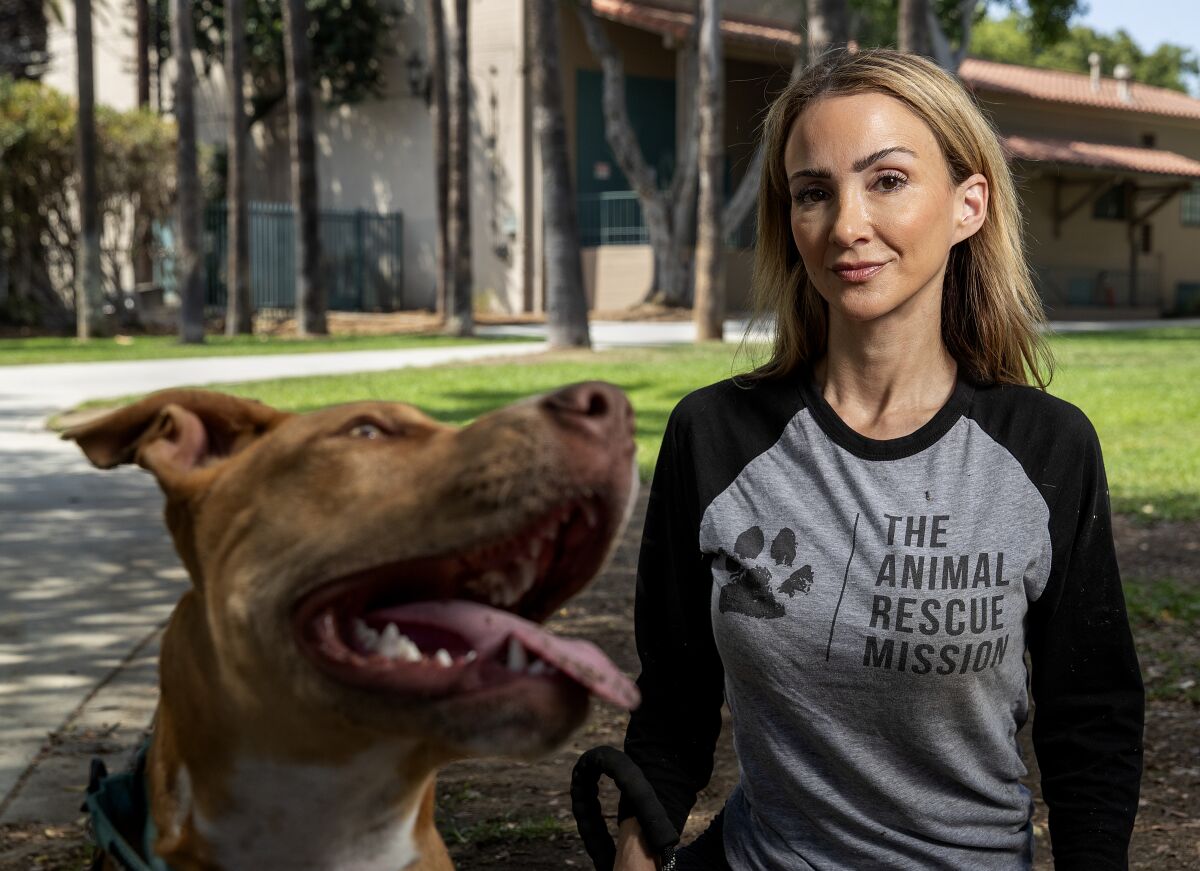The 5-year-old dog named Bruce had already suffered by the time he was housed in a kennel in the city of Los Angeles.
In May 2021, a shirtless, barefoot man arrived at the South LA shelter with the brown and white dog by his side. The man demanded that the dog be euthanized. After his request was denied, he pulled out a box cutter and slit the dog’s neck in front of horrified city workers.
Bruce spent the next seven months at the shelter as investigators searched for charges. He was shivering in his kennel and looked scared, visitors said, but remained off limits to volunteers for regular walks or time in the yard due to the ongoing criminal case.
Los Angeles Animal Services for years kept dogs seized in cases of abuse or neglect confined to their kennels, preventing them from exercising with volunteers, according to documents and interviews.
Already, understaffing and overcrowded shelters have resulted in long wait times for many dogs to walk. But until recently, the department’s practices regarding so-called evidence dogs left these animals even further neglected by depriving them of the socialization that could aid in their rehabilitation, animal activists say.
Even when it was clear that the evidence the dogs did not pose a threat or exhibit a pattern of aggression, the volunteers, who the department relies on to exercise and adopt animals, were ordered to do not handle them.
A sign posted on a kennel in April displays information about an evidence dog named Diva.
Animal Services changed its practice in June, telling staff that volunteers could start walking the animals, provided there were no safety concerns.
Annette Ramirez, who has served as acting director of animal services since February, told The Times the change was an “opportunity for improvement”.
The reversal came after attorneys complained to city officials and after The Times sent questions to the department about the evidence dogs.
The evidence dogs were largely off-limits for volunteers to walk around because, unlike other animals at the shelter, the dogs are not city property, according to animal services officials.
“We’ve been going back and forth around evidence dogs for a while,” Ramirez said at an Animal Services Commission meeting in late August, explaining the new practice.
Ramirez told The Times that the department has “a responsibility to safeguard and protect these animals that have come down to us. And we also have a responsibility to protect the public, staff and volunteers within our facilities.
Some evidence the dogs were kept away from the volunteers for fear an owner might come to the shelter and grab the dog while it was being walked, Ramirez said.
There have been “lots of break-ins” at shelters where owners have stolen their dogs, she said. Shelters also don’t want an evidence dog — who might be waiting for a hearing after attacking someone — to fight another dog or hurt someone, she said.
In some LA city shelters, evidence dogs are separated from dogs available for adoption or kept behind a locked door.
At the West LA shelter, workers call the area where the evidence dogs are held the “dungeon” because the room is so dark.
“The evidence that dogs have, historically, had the end of the stick,” said a shelter volunteer, who spoke on condition of anonymity for fear of reprisal.
Attorney Marla Tauscher, whose practice includes animal control law, questioned whether the city violated a California law requiring an adequate exercise area for confined animals.
“If you or I did that, we’d be in trouble,” Tauscher said of keeping a dog in a kennel for an extended period of time.
Animal Services spokeswoman Agnes Sibal said the city’s kennels provide adequate exercise space for animals.
Despite Ramirez’s announcement to allow evidence dogs to be walked, several volunteers told the Times that the dogs were not showing up in the department’s new walking system.
Sibal said the dogs show up and suggested the volunteers train with the department on the system, she said.
Bruce suffered a six-inch laceration to his neck in the attack, which was first reported by CityWatch. A veterinarian at the shelter saved him, according to an internal report.
Three months later, an Instagram video showed Bruce and a sign on his kennel saying he could not be accompanied. “He’s just sitting in this concrete cell,” the post read, describing the dog as “just done.”
The Los Angeles District Attorney’s Office charged the man who slit Bruce’s neck with two counts, and the dog was adopted last December.
Animal services and law enforcement agencies can request holdbacks from animals, but animal services decide whether evidence dogs can be exercised by volunteers.
“We do not determine how an animal is housed, including whether the animal should remain isolated,” Ricardo Santiago, a spokesman for the district attorney’s office, said in an email.
Holds are placed on animals for a variety of reasons, including dog attacks or cruelty to the owner. Evidence holds can last for days, months or years.
Although department practice officially changed in June, there is some evidence that dogs have been walked in the past. Some volunteers told the Times that they sometimes took out evidence dogs and the rules were unclear.
At the same time, animal services staff don’t always record when they walk dogs from shelters.
Sibal said the department could not detail the number of proof dogs found in shelters each year because numbers vary. At the end of June, there were 15 evidence dogs at Animal Services, she said.
Shira Scott Astrof, founder of the Animal Rescue Mission, wants the city to place dogs involved in cases of abuse or neglect into foster homes.

Shira Scott Astrof’s nonprofit Animal Rescue Mission rescued Griff, a 10-month-old pit bull mix.
(Mel Melcon/Los Angeles Times)
“Any dog that isolates himself in a noisy shelter, he has no idea what’s going on,” Astrof said. “[If] they already come from a situation that most likely involved abuse or neglect, their fear is going to get worse, they’re not going to eat, and they’re going to deteriorate.
Ventura County Animal Services has long treated evidence dogs the same as those from the general population, Director Jackie Rose said.
Evidence dogs are walked by volunteers, often during hours when the shelter is closed to the public. Sometimes they’re encouraged by trained volunteers, Rose said.
“There’s no one-size-fits-all answer to managing dogs,” Rose said. “We look at each animal as an individual and try to see what’s best for them.”
In Colorado, the Denver Animal Shelter allows dogs detained in cases of cruelty or neglect to be fostered because it is a “much less stressful environment than the shelter to recover or rehabilitate”, said said Emily Williams, director of communications and marketing for the city and county. from Denver.
In 2014, the Los Angeles Board of Animal Services Commissioners discussed the possibility of volunteers handling evidence dogs, and the department drafted new rules.
But the change never happened due to safety concerns for volunteers and staff, former animal services chief executive Brenda Barnette told The Times last month.
“We never had enough trained staff and volunteers to safely exercise the available dogs and also the potentially dangerous dogs, so we prioritized the available dogs,” Barnette said.
Even proof dogs that aren’t labeled aggressive can cope with long shelter stays. Diva, a one-year-old fawn-colored dog, was brought to South Los Angeles in March 2021 by LAPD officers investigating a dog abuse case.
She left the shelter in May 2022 and workers who saw Diva said they feared she was deteriorating in the kennel. Her records noted that she “bounced off walls” and spun “nonstop.”
Newsletter
Check out LA politics
In this pivotal election year, we’ll break down the ballot and tell you why it matters in our LA on the Record newsletter.
You may occasionally receive promotional content from the Los Angeles Times.
At one point, a vet approved her for volunteer-led walks. It is not known if she was walked, and there is no record of walks in the following months.
Another proof dog, Cash, spent seven months in a kennel. The gray 3-year-old came to the shelter in November after someone reported being attacked by multiple dogs, records show.
The cash was ruled in February as not dangerous, but a dispute over its ownership kept the case ongoing. He remained banned from walking due to his behavior, the department spokesperson said.
Cash’s notes indicate he growled and gave a “hard look” when he first arrived at the shelter.
Sibal, the animal services spokesperson, said staff were handling Cash on a pole, which can be used when employees feel unsafe around a dog.
Courtney Moran, who adopted Cash, said she saw no aggression from the dog.
Moran, who lives in Agoura Hills with his partner, Alex Zarris, described Cash as “terrified” when he left the shelter in June. He was startled by noises such as the crinkling of bags of poo.
Now he regularly cuddles with the couple, plays with their friend’s Yorkshire terrier and happily hunts lizards and rabbits.
“It’s just such a turnaround,” Moran said.
 Christ Yoder
Christ Yoder



/cloudfront-us-east-1.images.arcpublishing.com/gray/P5XQ6ZYQXVAM5MQ7O2X7G7SRHI.jpg)